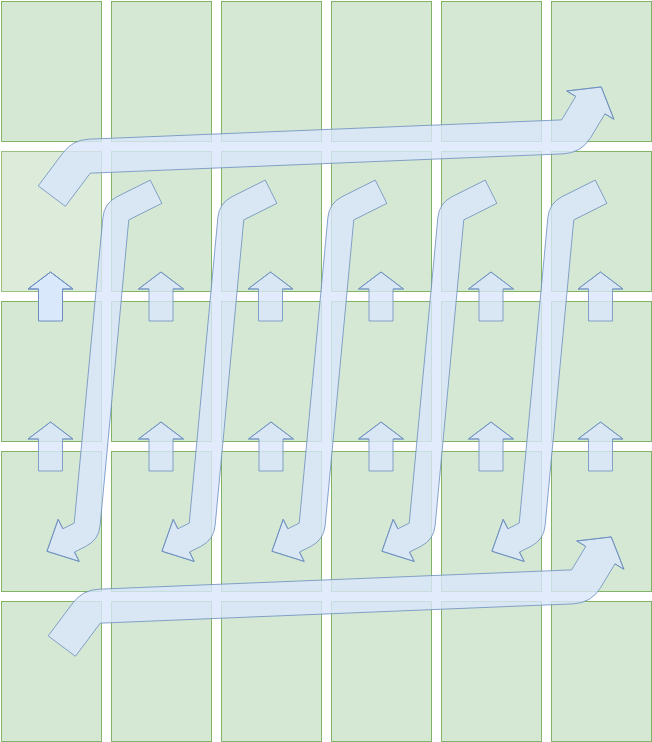
The arrows indicate the order in which cards from this imaginary 6 × 5 sheet could go into a hopper. This would be a stripe of width three.
Striped collation was the original method of collation used in Limited Edition Alpha. It continued to be used for many years, mostly in printings from Belgium.

The arrows indicate the order in which cards from this imaginary 6 × 5 sheet could go into a hopper. This would be a stripe of width three.
Imagine that each column of the print sheet forms its own sequence of cards from bottom to top and then looping. Then a "stripe width" of between two and five cards is chosen. That number of cards is taken from each column from right to left. After the left-most column, a new stripe width is chosen and the next cards will come starting from the left column again. (Note that cards in an individual pack may begin at any point in the pattern.)
The columns in striped collation are perfectly synchronized, so a stripe will match up with consecutive rows on the print sheet (or with some rows from the top of the sheet and some rows from the bottom of the sheet). A particular row can occur at any position in a stripe — the top, middle, or bottom.
Each slot on the sheet has multiple possible successor slots. The most common successor of a slot is the slot directly above it. The other possible successors are the four slots below in the next column to the left, except for slots already in the left-most column. Slots in the left-most column can only be succeeded by the slot above in the same column and the slot above in the right-most column.
Sometimes, different parts of a sheet are used separately. When this happens in striped collation, typically a sheet will be split into the top half of the bottom half or 5 rows and 6 rows if there are 11 total. Each half of the sheet is treated as its own smaller sheet. This means, for example, in a card in the top row may be followed by the card in the same column in the fifth row which would never happen if the sheet wasn't split. When half sheets are being used, the stripe width is usually between two and four (and not five).
Outlier stripe widths have been observed in some cases. Rarely, there can be stripes of width one. I have also observed stripes of widths up to seven. These outliers may not be possible for all sets.
Because of the two-dimensional nature of this collation method with respect to the print sheet, it is possible to reconstruct the print sheet in two dimensions by observing pack openings. The left-most and right-most columns can be determined, but there is no direct way to determine which row is the top row and which is the bottom row. Sometimes, though, it is possible to guess which row is the top row (for example, based on the distribution of colors on the sheet). If someone has found a miscut card from the top or bottom of the sheet, that can also help determine which row is on top.
Sheets using striped collation are generally back cut [1], and the ordering given here reflects that. A front cut sheet would have the reverse order. When giving sheet reconstructions, I am assuming back cut sheets. If the sheets were actually front cut, the sheet layout would be inverted.
Tavis King has reported on striped collation independently. Also check out his writeup on the Magic Librarities forum and his video explanation on YouTube.
[1] Information about corner cutting is from The Green Disenchant Project's "Corner Cutting" article.